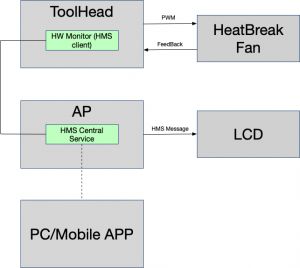¶ What is HMS
The Health Management System (HMS) is responsible for the collection & monitoring of the whole system status which includes:
- Hardware connections and working status, for example, the hotend fan's speed is too low.
- Mechanical status such as the belt tension;
- Printing issues such as first layer scan failure and spaghetti.
Once an abnormal event occurs, HMS will notify the user what the problem is. Users can then take the proper action.
¶ HMS Code Definition

1. Module ID
| Module ID | Module Abbreviation | Module Name |
| 03 | MC | Motion Controller |
| 05 | AP | Main Board |
| 07 | AMS | Automated Material System |
| 08 | TH | Tool Head |
| 0C | XCAM | Bambu Micro Lidar |
| 10 | Studio | Studio |
| 11 | APP | APP |
| 12 | AMS Lite | Automated Material System Lite |
2. Module No.
The number of module. Usually it is 0, but it could be over 0 if there is multiple modules connected to/in the printer, like the AMS.
3. Part ID
The id of part in specific module.
4. Part No.
The number of part in specific module.
5. Alert level
| Level | Definition |
| 0000 | Invalid alert |
| 0001 | Error (Printing task stopped, alert must be eliminated before starting a task) |
| 0002 | Warning (Printing task pause, alert must be eliminated before resuming the task) |
| 0003 | Info (Information only ) |
6. Error code ID
The ID of HMS alert algorithm.
¶ How does the HMS work
HMS is a distributed system which includes many status detectors and a central management unit. The below is a simple diagram to show how it works.

¶ Error Code
For each abnormal status, the HMS dispatches a unique error code for it. For example, 03000100010001 means the heatbed temperature is abnormal and the reason may be a short circuit. This error code can be then used to search for a solution in Bambu Lab Wiki.
¶ Notification
If the HMS detects that something is wrong in the system, it will pop up a error message along with the error code on the screen. The notification method for each message is different, based on the level of severity. For fatal errors, it will pop up a message window on the machine's display and request user confirmation. For warning statuses, the HMS will just show a notification message on the right of the display screen. The HMS will also send a notification message to the mobile app.
¶ Limitations
There are also some limitations for the HMS, for example:
- The HMS can not cover all the error/warning statuses due to the fact that it lacks some evaluation methods.
- Some errors can not be identified directly such as lost steps.
- The root cause for some errors is very complicated and the HMS can not identify the real reason for them. For example, a clog may be caused by improper print settings or improper operation. The HMS may only detect that an error occurred but won't know the real reason.
¶ How to use the HMS
Users can utilize the notifications of the HMS to know the status of the whole system including some mechanical and hardware errors, or why the printing has failed. There is a wiki page that gives a detailed description and a how-to for each error code which can be found here. While reporting errors, the HMS also gives a QR code which leads to the wiki page. So when seeing a HMS message, users should read the related wiki page carefully and follow the diagnostics steps to identify what the real problem is.
If users can not resolve the problem themselves, they can ask for an after sale service from Bambu Lab.